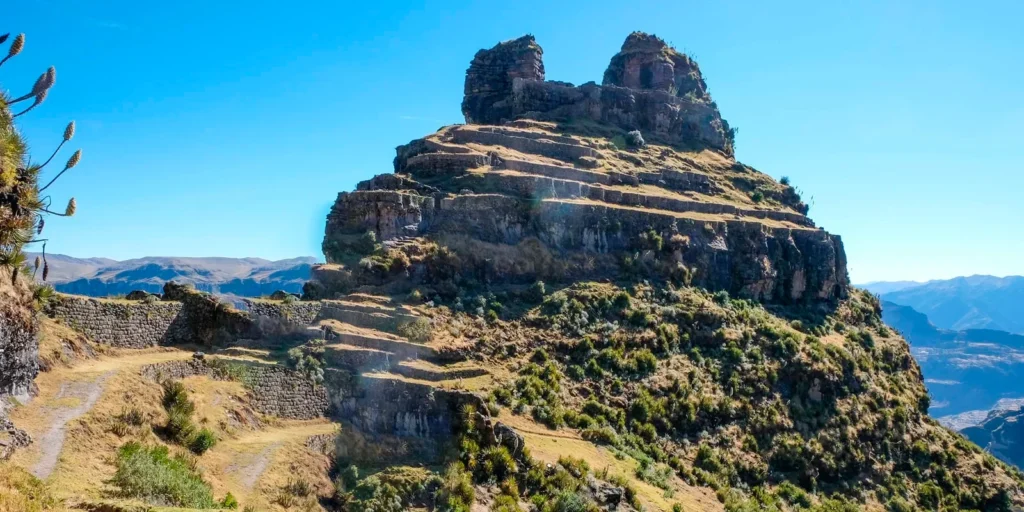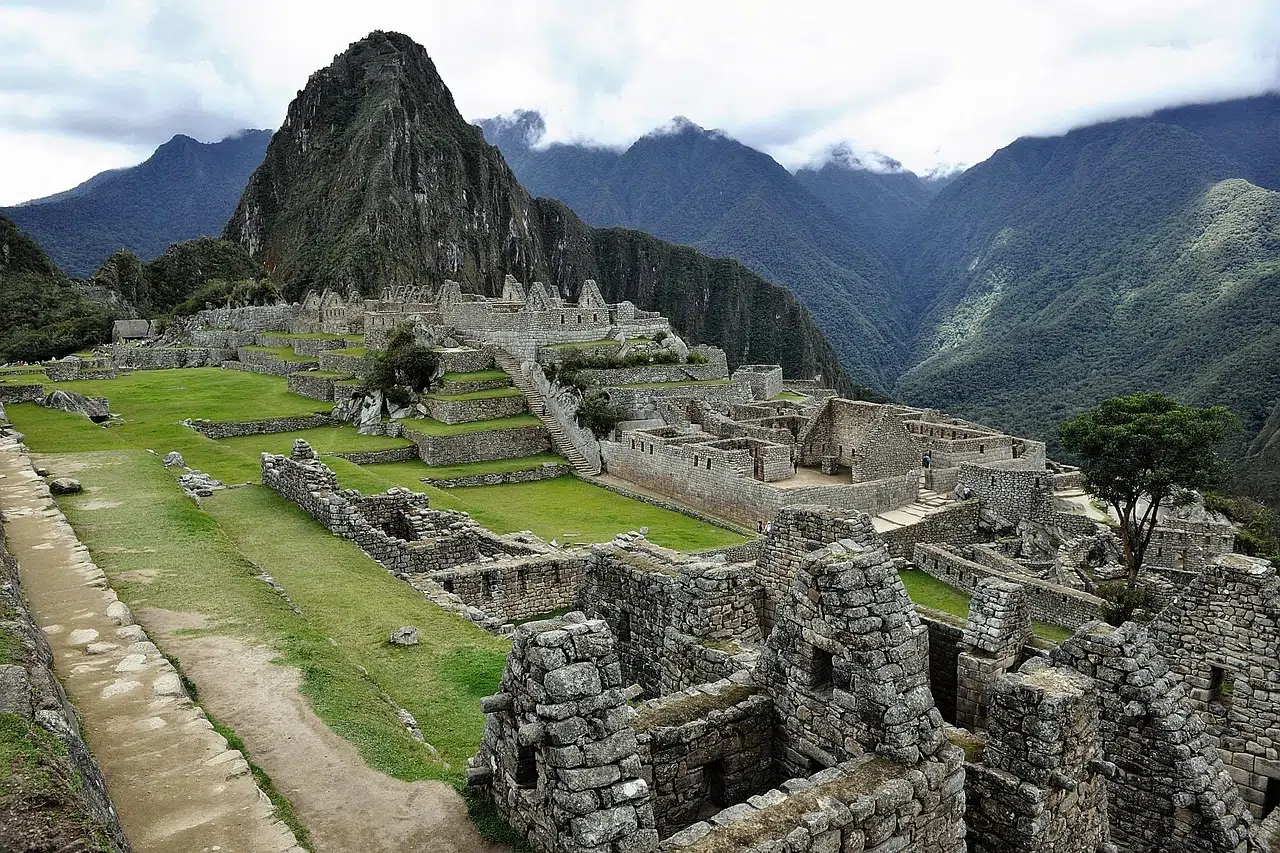Nestled high in the Peruvian Andes, Waqrapukara Cusco is a hidden gem often overshadowed by famous destinations like Machu Picchu or Rainbow Mountain. For travelers who want to explore Peru’s lesser-known yet breathtaking archaeological wonders, Waqrapukara offers a unique blend of history, stunning natural landscapes, and Inca heritage. This ancient fortress, dramatically perched atop a cliff overlooking the Apurímac River canyon, is one of the most intriguing but lesser-visited sites near Cusco.
But what exactly is Waqrapukara, and why should it be on your travel itinerary? Known as the “Horned Fortress” due to its distinctive twin peaks (“waqra” means “horn” and “pukara” means “fortress” in Quechua), Waqrapukara stands as a testament to the architectural ingenuity and cultural richness of the Inca civilization. This guide will cover everything you need to know to make the most of your visit, from the fortress’s history to practical tips for your journey.
Table of Contents
History and Meaning of Waqrapukara
The Origin of Waqrapukara’s Name
The name “Waqrapukara” perfectly captures the imposing and mysterious nature of this ancient site. The term comes from the Quechua words “waqra,” meaning “horn,” and “pukara,” meaning “fortress.” The fortress’s two horn-like rock formations stand prominently against the sky, lending a dramatic appearance to the site and making it a natural lookout over the canyon below.
Waqrapukara’s Significance in the Inca Empire
Waqrapukara dates back to the pre-Inca period, with some evidence pointing to its origins with the Qanchi people, an indigenous community that existed before the rise of the Inca Empire. However, it was the Incas who later expanded and developed Waqrapukara into a sacred fortress. The site is thought to have served as a ceremonial center, a place of strategic military significance, and possibly a point of astronomical observation. Like other Inca sites, Waqrapukara reflects the empire’s spiritual connection to the natural world, with its high-altitude location and alignment with surrounding peaks and celestial phenomena.
Waqrapukara holds an important cultural place in Andean tradition and spirituality, often regarded as a sacred space. According to local beliefs, it is a place where ancient rituals were performed to honor the Andean gods, particularly the Apus, or mountain spirits. This reverence continues to this day, as local communities celebrate the site and hold spiritual ceremonies in its honor.
You can also read:
- Palcoyo Cusco: The Complete Guide to the Alternative Rainbow Mountain
- The Ultimate Guide to Humantay Lake Cusco: Everything You Need to Know for Your Adventure
- The Ultimate Guide to Rainbow Mountain Cusco, Peru: Everything You Need to Know
How to Get to Waqrapukara
Visiting Waqrapukara requires some planning and effort, but the journey is well worth it for adventurous travelers. Unlike more accessible tourist spots, Waqrapukara demands both transportation and hiking, giving the experience a special allure.
Options for Reaching Waqrapukara
- Guided Tours from Cusco
One of the easiest and most popular ways to reach Waqrapukara is by booking a guided tour from Cusco. Guided tours are convenient as they include round-trip transportation, experienced guides, and often meals. Most tours are structured as full-day trips, leaving early in the morning and returning by evening. Some companies also offer multi-day treks that include camping near the fortress for a more immersive experience. - Public Transportation + Hike
Independent travelers can reach Waqrapukara using public transportation, but this route requires a bit of logistical planning. First, take a bus from Cusco to Acomayo, a small town close to Waqrapukara. From there, you can arrange a ride to the starting point of the hike or embark on foot. This option is more affordable but requires extra time and is recommended only for those comfortable navigating remote areas. - Self-Drive + Self-Guided Hike
If you’re confident with driving, renting a vehicle from Cusco and driving to the trailhead is an option. This approach allows for flexibility in scheduling and exploring the surrounding area. Keep in mind that the road can be challenging, so a 4×4 vehicle is often recommended. After reaching the closest point by car, a short but rewarding hike is required to reach the fortress.
Hiking to Waqrapukara
For many, the journey to Waqrapukara is as much a highlight as the site itself. The hike to the fortress offers scenic landscapes, high-altitude challenges, and a chance to connect with nature.
Difficulty Levels of the Trek
The trek to Waqrapukara is considered moderately challenging, particularly due to the altitude (around 4,300 meters or 14,100 feet) and rugged terrain. It’s essential for hikers to be physically fit and acclimated to high altitudes to enjoy the experience safely. Even though the trek is short in distance, it involves steep ascents and narrow paths, which can be tiring at high altitudes.
Recommended Routes and Trails
- Day Hike (Shorter Route):
This route is ideal for those looking to visit Waqrapukara in a single day. Most guided tours follow this trail, which involves a 2-hour drive followed by a 2 to 3-hour hike. Along the way, you’ll be rewarded with panoramic views of the Andes, with plenty of photo opportunities. - Overnight Camping Trek (Extended Route):
For a deeper experience, consider an overnight trek to Waqrapukara. This multi-day trek allows for a slower pace, giving hikers the chance to enjoy the scenery, camp near the fortress, and witness sunrise or sunset from the site. This route is highly recommended for photography enthusiasts and those who enjoy stargazing.
Best Time to Visit Waqrapukara
Waqrapukara’s high-altitude location means it’s best to plan your visit around seasonal weather patterns.
Dry Season vs. Rainy Season
The best time to visit Waqrapukara is during the dry season, from May to September, when the weather is typically clear and temperatures are mild. The rainy season, from October to April, can make the trails muddy and slippery, making the hike more difficult and potentially dangerous. However, if you do visit during the rainy season, be prepared with waterproof clothing and sturdy hiking boots.
Month-by-Month Guide
- May to September (Dry Season): Expect clear skies and cooler temperatures, ideal for hiking. This is also the busiest time, so expect more visitors.
- October to April (Rainy Season): Frequent rain showers and fog can obscure views, and the trail conditions can be challenging. However, this season offers lush green landscapes for those who don’t mind a little rain.
What to Expect on a Waqrapukara Tour
Most tours to Waqrapukara from Cusco follow a structured itinerary that includes transportation, hiking, and guided exploration of the fortress. Here’s what you can typically expect on a Waqrapukara day trip:
- Early Morning Departure: Tours typically depart from Cusco between 3-5 a.m. to ensure plenty of time for the hike and exploration.
- Scenic Drive: After a couple of hours driving through rural Andean landscapes, you’ll reach the trailhead, where the hike begins.
- Guided Hike and Exploration: Guided hikes provide insights into the fortress’s history, culture, and architecture, making the experience informative and engaging.
- Return to Cusco: Most tours end with a return drive to Cusco in the late afternoon or early evening.
Tips for a Safe and Enjoyable Visit
- Prepare for Altitude: Waqrapukara sits at over 4,300 meters, so altitude sickness can be an issue. Acclimate yourself in Cusco for a couple of days and stay hydrated.
- Dress in Layers: Weather in the Andes can change rapidly. Dress in layers to stay comfortable.
- Bring Snacks and Water: While some tours provide meals, it’s a good idea to pack extra snacks and plenty of water.
- Wear Appropriate Footwear: The trails can be rocky and slippery, so sturdy hiking boots are essential.
Conclusion: Why Waqrapukara is a Must-See Destination in Peru
Visiting Waqrapukara Cusco offers a unique opportunity to explore a hidden fortress that embodies the ingenuity and spirituality of the Inca civilization. Unlike more crowded sites, Waqrapukara provides an intimate and rewarding experience for those willing to venture off the beaten path. With stunning landscapes, rich history, and a challenging trek, Waqrapukara is an unforgettable destination for adventurers, history enthusiasts, and anyone looking to connect with Peru’s fascinating past.



